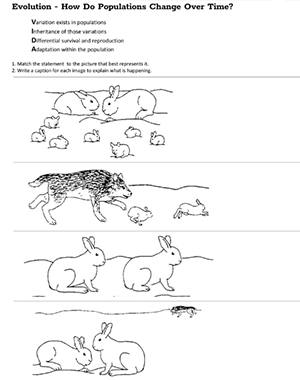
This short activity was designed to compliment evolution lessons that use the VIDA chart for helping students understand the process of evolution. VIDA is an acronym for the steps that describe how evolution occurs by natural selection.
Variation: Individuals in a population differ in some trait. For the bunnies on the graphic, some of them have long legs and some have short legs.
Inheritance: The trait is inherited, or passed from parents to offspring. On the graphic, an image shows two bunnies with several baby bunnies.
Differential Survival and Reproduction: More offspring are born than can survive, and individuals with the more favorable traits are more likely to survive and reproduce. On the graphic, a wolf is shown chasing two bunnies, the one with the longer legs appears to be getting away.
Adaptation: The frequency of the trait in the overall population will increase, because the survivors pass their genes on to their offspring. On the image, two bunnies are shown with long legs.
Students are asked to determine the ORDER for each of the images by designating which concept (VIDA) goes with which image. They are then asked to caption each image to describe what is happening. I usually do this as a class project, where I allow students 5 minutes to come up with the order and the captions, then we discuss each frame and make edits.
If we have already done the rock pocket mouse activity, I will ask students to create their own cartoon showing how the pocket mice adapt to either sandy or rocky substrates.
I have also used this VIDA method when discussing the evolution of other organisms, such as anoles and elephants, with many lessons coming from HHMI Biointeractive.
I also make a space on the board or side wall to write VIDA in large letters with a simple description to remind students how natural selection happens. This consistent reinforcement seems to improve their test scores and overall understanding, though some do struggle with the last concept: adaptation.
I’m cautious when discussion adaptation, for example, with the bunny graphic, I avoid saying that the “bunnies changed” and instead say the POPULATION changes. It can be difficult to correct this misconception that individuals change rather than overall populations.
I also avoid using the phrase “survival of the fittest” because my students don’t always understand the concept of “fitness.” Instead, I suggest that natural selection is about picking “winners” and “losers.” Winners get to live and pass on their DNA, and losers die.
Time Required: 10-15 minutes
Grade Level: 9-12

